
The Business of Fashion
Agenda-setting intelligence, analysis and advice for the global fashion community.

Agenda-setting intelligence, analysis and advice for the global fashion community.
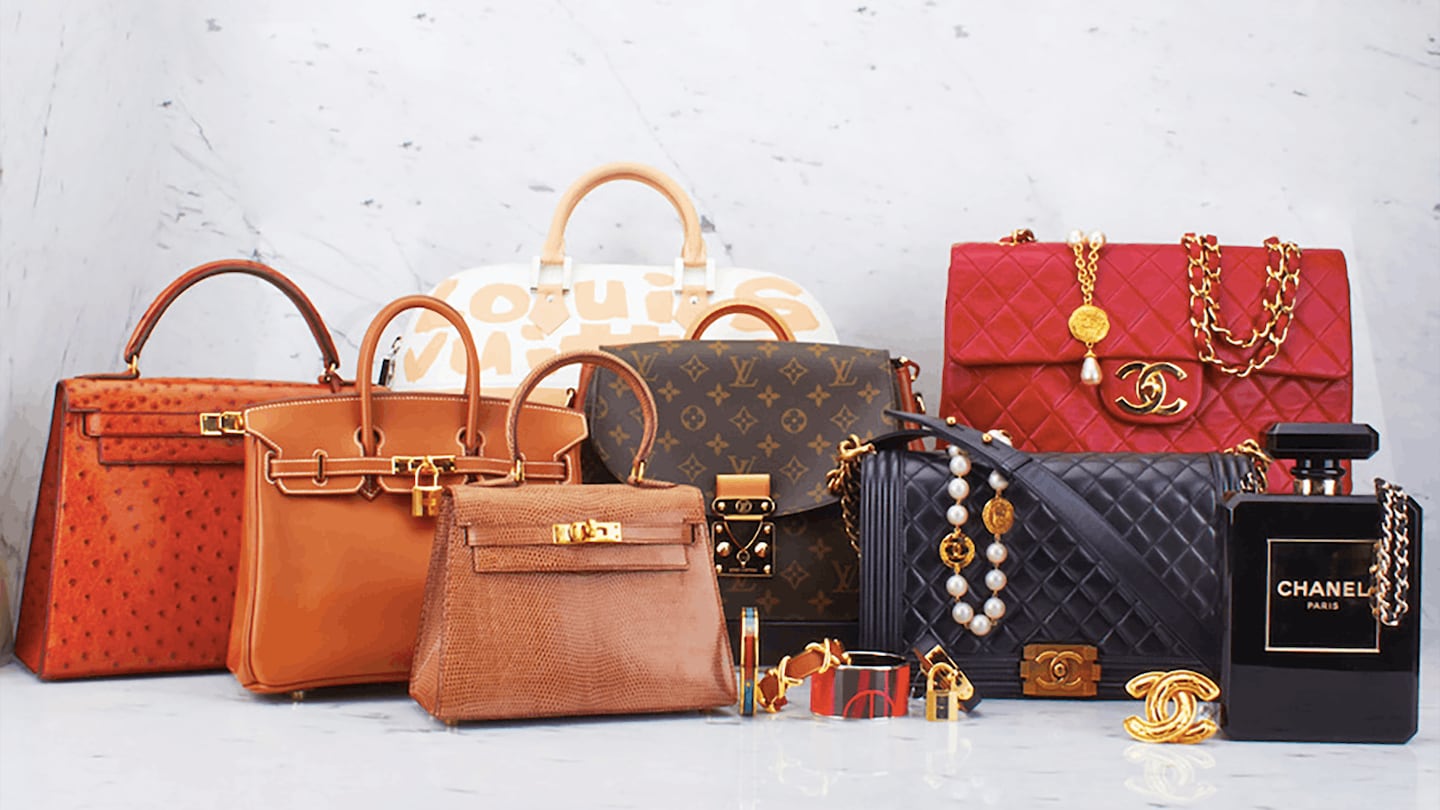
SHANGHAI, China — It’s not easy getting a handle on what Chinese consumers want — or don’t want — in today’s complicated and rapidly changing landscape.
One minute the focus is on "revenge spending" and lines of shoppers outside of Chanel; the next we're told there is a race to the bargain basement as consumers experience the biggest economic shock China has endured in generations.
The most obvious reason for these perceived contradictions is that China is a big place. There is no single prevailing wind in a market of 1.4 billion people who live in a country that is geographically, demographically and climatically more like a continent. Rather, there are a multitude of breezes, representing varied trends by consumer segment and price point.
The great diversity of consumer behaviour that exists within China also explains why there has not been a consensus on the potential of the luxury resale market. One minute the focus is on forecasts predicting sales of billions of dollars; the next we’re told it’s nothing but a niche opportunity. What gives?
ADVERTISEMENT
Newness is a prized commodity in China, with pre-owned items associated with a time before.
Traditionally, vintage fashion has struggled in China for cultural and historical reasons since older generations tend to view pre-worn items with suspicion, as a superstitious belief that someone’s luck can be carried on in their possessions makes taking on someone else’s (potentially bad) luck a major risk.
There is also the simple fact that newness is a prized commodity in China, with pre-owned items associated with a time before the country’s economic opening up, when people were poorer and the country more broadly at a low ebb.
This is a mindset that lingers for many in the world’s largest luxury market: "Why would I pay for a secondhand Chanel bag, when I can afford to go into a store and buy a brand-new Chanel bag?" And even for those motivated by sustainability or to save money by buying comparatively affordable vintage fashion, will the notion of secondhand clothes sit right with them during a contagious pandemic?
Having waited in the wings for years for China’s secondhand market to evolve, the big resale platforms in Europe and the US must now be asking themselves these and other burning questions. The answers are more nuanced and complex than ever.
Vintage Means Individuality for China’s Youth
In 2018, when Annie Hou was vice president of strategy and innovation at Ogilvy, she undertook a research project in which she interviewed young Chinese consumers from around the country about what drives their luxury consumption.
She found, unsurprisingly, a high level of knowledge about luxury brands, with consumers in third-tier cities able to list dozens of global luxury brands off the top of their heads. Many of the post-90s shoppers Hou interviewed for the project were children of middle class households and many were second-generation luxury consumers, though their reasons for buying luxury were very different from those of their parents.
“They are only children and have grown up as China’s economy grew very fast, so they have been raised with the freedom to grow their own personality,” Hou explained. “Whatever they consume, they want to use that to build their own personal identity and image.”
ADVERTISEMENT
This is potentially a major plus for vintage fashion — a sector which has unique product at its core. When everyone else is going out to buy the it-bag of the season, an increasing number of young consumers want what no one else has. Wearing a relatively obscure luxury item from years ago is more unique in the context of today than any item from that brand’s latest collection.
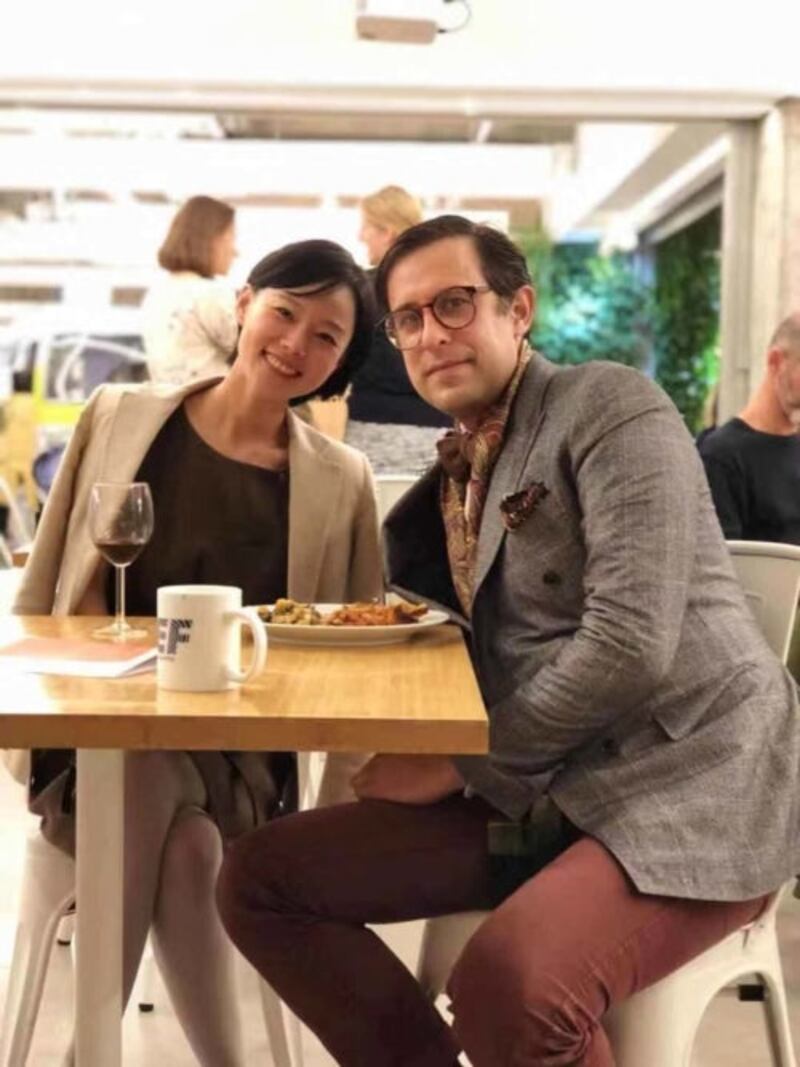
Jane Jia and Nels Frye opened the Pawnstar offline store in 2016 | Source: Courtesy
Pawnstar, a cleverly named consignment store that has been operating in Shanghai since 2016, caters to these younger consumers. The store was started by Jane Jia and her husband, Nels Frye, who found themselves at the forefront of a burgeoning movement, routinely clocking annual sales growth of 40 percent per year.
"Our main demographic is 30 something women; they might be business owners or work in corporations, but they just have style," Frye said of Pawnstar's customers, who shop both in store and via livestreams on platforms such as Mogujie and ShopShops.
“Online it’s mostly second-tier city customers, [from] places like Chongqing, Chengdu, definitely a lot from those places, but they can come from anywhere,” he added.
Unusually, Pawnstar’s business was built on the back of ready-to-wear consignment, modelled on the ubiquitous consignment stores in countries like Japan, where data from Berenberg Bank shows sales of pre-owned goods account for 10 percent of the luxury market, compared to just 3 percent in China.
Chinese tech publication 36Kr has estimated that 85 percent of China’s secondhand economy is driven by those under the age of 35.
One of those consumers is sociology student Bonnie Wang, 33, from Shanghai. Her love of vintage pieces from 1990s and early 2000s era Margiela and Comme des Garçons was fermented by frequent shopping trips to Japan.
ADVERTISEMENT
“I think there is a huge opportunity [for luxury resale] as the economy slows down a little bit, making people maybe cut down their luxury spending — and at the same time. people are looking at style more than trends,” she said, suggesting that the belt-tightening efforts of some consumers could benefit China’s bourgeoning luxury resale market.
China’s Resale Landscape
The resale market’s growth has been significant, with research conducted by the China Centre for Internet Economy Research (prior to the coronavirus pandemic) predicting sales of secondhand goods in China would reach one trillion yuan ($145 billion) this year, double the amount seen in 2017.
More specific data for the luxury industry was published in the 2019 Chinese Secondhand Luxury Industry Report, showing that in 2018, sales of pre-owned luxury products amounted to 12.1 billion yuan ($1.7 billion). This places the Chinese market well behind the $5 billion and $6 billion resale luxury markets in Japan and the US respectively, but the yearly growth rate was impressive, clocking 20 percent annually for the last four years, a rate expected to continue, or even accelerate, this year (again, before the pandemic).
The future potential of the market explains why Pawnstar wasn’t the only player to enter the secondhand luxury market in recent years. Most of the secondhand sales activity in China happens online, with data from QuestMobile showing 60 percent of consumers in major cities report using secondhand sales apps. Unsurprisingly, the largest resale player in the general merchandise category is an Alibaba-backed company, Xianyu, which boasts more than 200 million users.
In the secondhand luxury sector, the major online player is Plum, also known by the Chinese name Hongbulin, which first launched in 2017 and has raised $58.4 million in six rounds of funding, including $20 million in its latest Series B round last August.
Like international luxury consignment sites, Plum operates on a consumer to consumer model, with the platform in the middle, connecting consumers who want to sell with those who want to buy and providing all the photography, authentication, pricing and logistical support to facilitate those sales. Unlike The RealReal, which offers tiered commission rates, Plum charges a 20 percent commission across the board.
Local players have emerged in something of a vacuum in China.
These local players have emerged in something of a vacuum in China, with major international online luxury resellers almost completely absent from the market.
In 2017, following a $65 million round of funding, Vestiaire Collective announced China would be a major target for expansion, both from a customer and product acquisition standpoint. That push never really happened.
This April, when the company announced it had raised an additional €59 million ($64.6 million), from investors including Korelya Capital, a venture capital firm known for helping European tech companies expand in Asia, Vestiaire Collective said it was with an eye to expansion in Japan and South Korea this year, rather than China.
“We are seeing indicat[ions] that China will… be a big supply market for us moving forwards… [but] at the moment, we don't have plans to enter China this year,” a spokesperson for Vestiaire Collective told BoF.
The world’s largest secondhand luxury marketplace, The RealReal, confirmed to BoF that it doesn’t ship to mainland China at all and has "no expansion plans to share at this time". Some consignment companies contacted by BoF said they had been in contact with The RealReal about potentially sourcing product from China, but the idea of accessing the Chinese consumer market for sales remains an exceedingly complicated business for secondhand platforms.
Firstly, it’s almost impossible to import secondhand clothing into China. There are smaller players who bring secondhand products in via daigou agents, and other platforms that facilitate transactions, rather than holding product themselves, both of which would be unsuitable for The RealReal’s business model. To do business in China, they would almost certainly have to set up a local legal entity and then source product from within the country to sell to Chinese consumers, which would take a significant investment and may also have the drawback of not being as appealing to Chinese consumers as product sourced from elsewhere.
Not only do international players need to find the fastest and most efficient shipping and delivery routes based on where items are being sold from, as well as dealing with customs, duties, taxes, legal restrictions and currency fluctuations, they would also, at this point, need to do so after ceding the first-mover advantage to local players. However, there is also an argument that Chinese consumers would support international resale players because of the perception that their experience and qualifications make them trustworthy when it comes to authentication.
The Question of Counterfeits
Perhaps even more of a hindrance to the luxury resale market in China than the cultural stigma attached to secondhand goods is the lingering spectre of counterfeits.
"A lot of counterfeiters are really, really [adept] at taking the genuine hardware of an old bag and putting it on a fake bag, for example," China Market Research Group Managing Director Ben Cavender said. "It's very difficult for people to know if they are buying a real product."
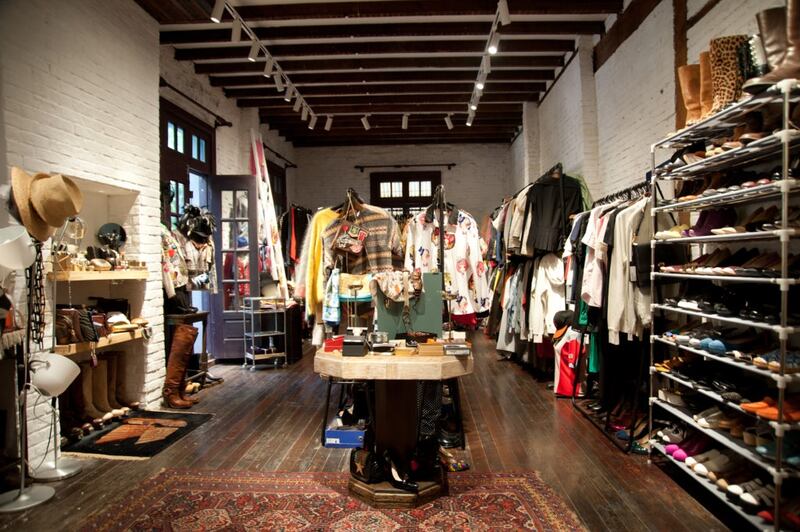
Shanghai's Pawnstar is one of China's leading luxury consignment stores | Source: Courtesy
One way Pawnstar and Plum have worked to combat consumer discomfort over counterfeits is through livestreaming, which allows for detailed explanations of product and provenance, as well as the opportunity for potential consumers to ask detailed questions.
Both of these luxury resellers also source a good deal of their products from outside of China, circumventing stringent laws on bringing secondhand clothing into the country by focusing their international partnerships on other product segments, for example, bags and jewellery.
Plum has aligned itself with well-respected consignment stores in Japan, which are familiar to the well-travelled female customers who make up their audience. This not only improves their inventory, but also reassures customers that products are less likely to be counterfeit than those sourced from within China.
Frye says Pawnstar is increasingly sourcing products from the US, where there is an “almost limitless supply” of high-quality goods from the mid-20th century that are completely new to Chinese consumers. The fact that it is sourced from the US also helps consumer confidence in its authenticity.
Coronavirus: Help or Hindrance?
If top-line numbers are any indication, the coronavirus outbreak has been something of a boon for the broader resale market.
According to general merchandise resale player Xianyu, the platform’s average transactions and gross merchandise volume in March broke records. New sellers increased by 38.8 percent and newly listed products by 40 percent compared to the same period last year.
Something similar happened in the luxury fashion resale sector. In the same month, Plum saw its monthly active users increase by 40.4 percent year-on-year. Xu Wei, Plum’s chief and founder, told local media that sales in March reached an all-time high. “An increasing number of people were selling secondhand luxury products in exchange for cash,” Xu said.
“[At the same time] since almost everyone was staying at home to help curb the spread of Covid-19, the time spent on online shopping became more prolonged. Therefore, the transaction volume increased,” she added.
For Pawnstar too, online business remained brisk, even as footfall in the Shanghai store has fallen considerably. For its business model overall, however, the coronavirus outbreak has presented more risk than reward.
“Profit has been very low in the physical store. We’ve been focusing more on jewellery, that seems like the safest bet. Taking people’s consignment is fraught with potential things that would make people nervous,” Frye said.
Pawnstar has actually halted consignment of ready-to-wear for the time being. “I can only speak for my own experience, but we are really worried that people will see secondhand stores as a bit of a risk [while concern about Covid-19 runs high],” he added.
With the pandemic seen both as a driver of the trend towards secondhand consumption and as a potential spanner in the works, questions remain as to whether luxury resale will take market share from new luxury branded products. The sense of urgency is pronounced in a year in which global players will be looking at domestic Chinese spend to prop up business lost from travel retail and forced closures.
So far, the answer seems to be probably not, or at least not in any significant way. New luxury customers in China will still make their first foray via major players like Louis Vuitton; established luxury consumers will continue to diversify the number of brands in their collections; and a small number of younger luxury consumers will gravitate towards luxury resale as a way of diversifying even further, regardless of the macro-economic landscape.
According to Ben Cavender, the growth of the secondhand luxury market in China is a real phenomenon, but it’s not actually one being driven by frugality in the face of economic shocks accelerated by the coronavirus outbreak. What he believes is driving the market is actually a more experienced and sophisticated young luxury shopper in China, who is looking beyond trends as they invent and reinvent their own personal style.
“It really is being driven by this consumer sophistication and the need to be a chameleon, versus saving money,” he said.
时尚与美容 FASHION & BEAUTY
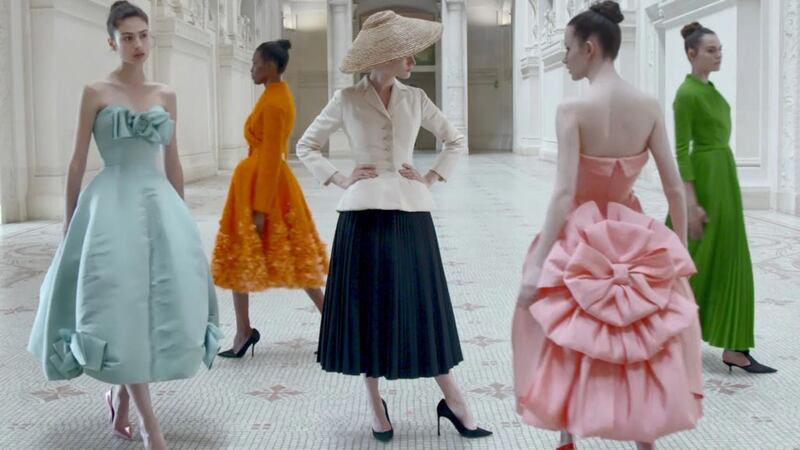
A promotional image from Dior's exhibition | Source: Courtesy
Dior to Revive Real World Fashion Events in China
As fashion events worldwide continue to be either cancelled, postponed or held exclusively online, Dior is wading back into the real world of events with its "Christian Dior: Designer of Dreams" retrospective, which is coming to Shanghai's Long Museum from July 28 to October 4, following previous showings at the Musée des Arts Décoratifs in Paris and the Victoria and Albert Museum in London. (Dior)
C-Beauty Unicorn Bats Away IPO Rumours
Perfect Diary has denied it has plans to IPO in the first half of 2021, refuting recent speculation in Chinese media. Following a fresh capital injection of $100 million raised in April, the C-Beauty giant boasts a $2 billion valuation, but as a consumer goods company, it's lack of profitability amidst breakneck expansion and an expensive brick-and-mortar rollout currently underway makes an IPO unlikely in the short term. (36Kr)
科技与创新 TECH & INNOVATION

Bilibili and Louis Vuitton’s League of Legends crossover | Collage by BoF
Bilibili Stock Price at Record High Following Earnings Announcement
China's entertainment powerhouse and video sharing website, Bilibili, this week announced its 2020 first-quarter financial results, closing March 31. The site's number of monthly active users hit 172 million, representing an astonishing 70 percent increase year-on-year. Meanwhile, Bilibili's total net revenue reached $327 million — a 69 percent growth over the same period last year. Both metrics vastly exceeded market expectations and saw Bilibili's stock price reach new highs on May 18. The company's total market cap is nearly $11.6 billion. (Jing Daily)
Baidu Invests $70.5 million in Livestreaming
Baidu, China's biggest internet search company and artificial intelligence champion, said it is investing a further 500 million yuan ($70.5 million) to boost its livestreaming services, aiming to cultivate one thousand star content creators amid a surge in online users during the coronavirus pandemic. The size of China's livestreaming market reached 433.8 billion yuan ($61 billion) in 2019 and is expected to be double that in 2020, according to a report by data analysis firm iiMedia Research. (South China Morning Post)
消费与零售 CONSUMER & RETAIL
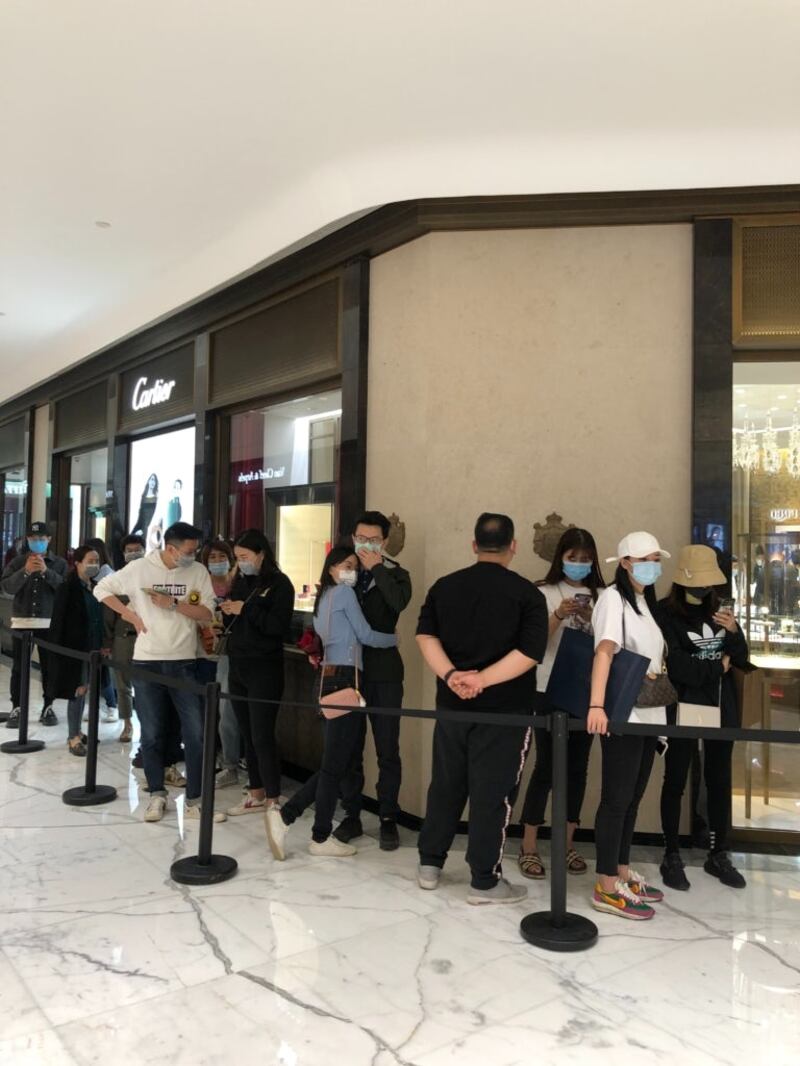
Lines formed outside high end jewellers at Beijing's SKP shopping mall in response to its anniversary promotions | Source: WeChat
Crowds Rush to Beijing’s SKP Malls
Beijing's SKP and SKP-S shopping malls seem to have landed on a winning formula for winning customers back to brick and mortar in China's capital, which has seen a slower return to offline retail than other centres around the country following China's coronavirus outbreak. From May 9 to 20, the malls held anniversary events and "brand day" promotions featuring luxury titans such as Gucci, Prada and Saint Laurent. Jewellery and watch brands have also been roped in and customers with purchases of more than 100,000 yuan ($14,000) were eligible for an electronic gift card in return, prompting a significant increase in traffic. (BoF China)
InTime Department Stores See Month-to-Month Gains
At a time when department stores around China and the world continue to struggle, the 65 stores in Intime's network, which was acquired by Alibaba in 2017 as part of the tech giant's push into new retail, saw monthly gains of 50 percent for in store foot traffic from May 1 to 3, over the same period in April. To boost local consumption and consumer confidence, Intime has distributed one billion yuan ($140 million) in vouchers and discounts since April and ramped up sales efforts for the extended Labour Day holiday. (Alizila)
政治,经济与社会 POLITICS, ECONOMY, SOCIETY
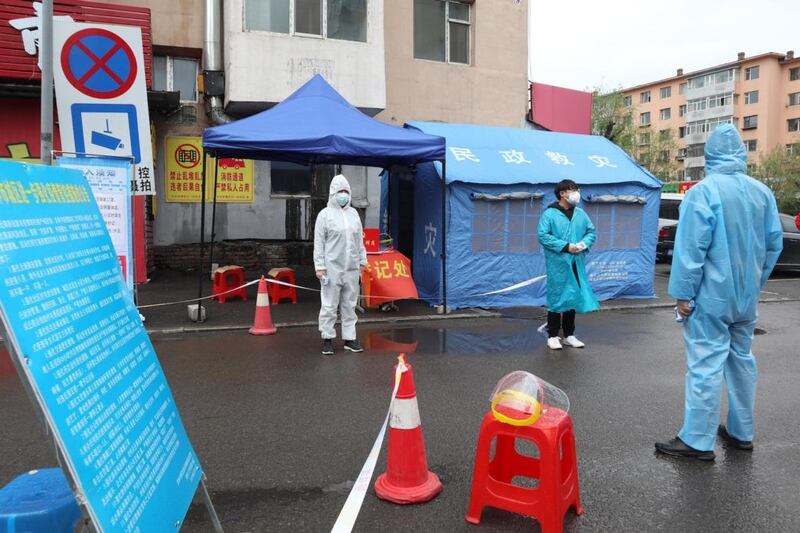
Volunteers wearing protective suits stand guard at the temperature checkpoint at the entrance of a residential community in the Jilin Province of China | Source: Getty Images
China’s Northeast Reintroduces Lockdown Measures to Contain New Outbreak
Chinese authorities have sealed off the North Eastern city of Shulan in Jilin Province, home to about 700,000 people, after an outbreak of coronavirus, imposing measures similar to those used in Wuhan, the epicentre of China's virus outbreak. All villages and residential compounds in the city were closed off, and only one person from each household is allowed out for two hours every second day for essentials. On Tuesday, the nearby city of Jiaohe stopped public transport both within the city and between the city and neighbouring counties until further notice. (The Guardian)
The Agenda for Beijing’s Biggest Political Meeting
China's top legislature and political advisory body will hold annual sessions this week, more than two months after this key political event was postponed due to the coronavirus outbreak. On the agenda for the meetings will obviously be ongoing pandemic control, but also revised growth targets, poverty alleviation, boosting employment and continuing work on drafting a civic code for China. (Xinhua)
The Future of Fashion Resale Report — BoF Insights
BoF’s definitive guide to fashion resale, covering the evolution of the market, its growth and upside, consumer behaviours and recommendations for crafting a data-driven resale strategy. To explore the full report click here.
The Future of Fashion Resale is the first in-depth analysis to be published by the BoF Insights Lab, a new data and analysis unit at The Business of Fashion providing business leaders with proprietary and data-driven research to navigate the fast-changing global fashion industry.
China Decoded wants to hear from you. Send tips, suggestions, complaints and compliments to our Shanghai-based Asia Correspondent casey.hall@businessoffashion.com.
With consumers tightening their belts in China, the battle between global fast fashion brands and local high street giants has intensified.
Investors are bracing for a steep slowdown in luxury sales when luxury companies report their first quarter results, reflecting lacklustre Chinese demand.
The French beauty giant’s two latest deals are part of a wider M&A push by global players to capture a larger slice of the China market, targeting buzzy high-end brands that offer products with distinctive Chinese elements.
Post-Covid spend by US tourists in Europe has surged past 2019 levels. Chinese travellers, by contrast, have largely favoured domestic and regional destinations like Hong Kong, Singapore and Japan.